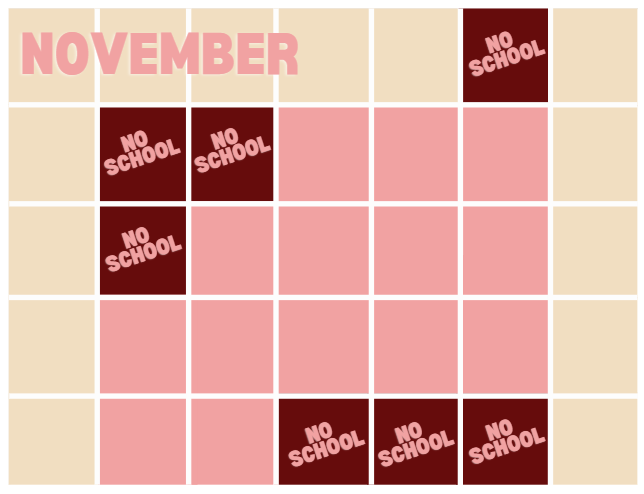District 7 students will be at school only 14 days this November, as holidays, parent-teacher conferences and teacher institutes disrupt regular attendance.
“I think it’s the same number of days off, they’re just clustered together a little bit differently [than in past years],” said Mollie Rice, a long-time math teacher.
Teachers have reorganized plans to adjust for November’s frequent breaks – the longest being a six-day weekend starting next Thursday. Ms. Rice expects her calculus AB and BC students to keep up with work and come to school on attendance days, since she’s under pressure to keep them on-track with College Board.
“The AP test is on May 12 whether we push school days back or not, so we have to keep moving and keep getting through the same material,” Ms. Rice said.
According to English teacher Deanne Voegele, November will feel different from one department to another. Though Ms. Rice and other math teachers must follow more sequential curriculums, Mrs. Voegele said English teachers have a flexibility that is useful in situations like this.
“We can kind of move things around, and they really can’t,” Mrs.Voegele said.
Still, she’s had to plan. Her students are scheduled to wrap up their “Of Mice and Men” essays before next Thursday, for example, because she prefers that breaks fall between units instead of interrupting them.
Art teacher Stacy Snead, who came to EHS just this fall, said she’s had challenges molding her curriculum to the disjointed November calendar.
“With all the projects … the timeline is something I’m working through,” Mrs. Snead said. “If I’ve never done the project, I have no idea what the actual timeline is going to be.”
Mrs. Sneed largely teaches two-dimensional projects, which she said are easier to leave alone for a few days than three-dimensional work, which often uses drying materials like plaster or clay.
“But carrying the concepts along and using new materials and trying to keep that retention over a long period of time is tricky,” she said. “It’s like a sport, if you don’t do it for a week or two you get a little rusty.”
She’s also struggling to balance semester-long classes between the fall and the spring. There are fewer days in first semester, but she tries to give both groups a similar experience.
“It’s supposed to be the same class first semester and the same class second semester,” Mrs. Snead said. “How do we reconcile that with not having the same amount of days?”
French and Spanish teacher Christel Schwarz schedules in a live document that her students can view. She said a November full of short weeks means modifying the schedule often to make sure quizzes and tests don’t fall directly after long weekends.
“It’s just kind of taking it week by week,” Mrs. Schwarz said. “But I feel that since I use a live document, that makes it easier because then the communication is immediate to the students. They can see the changes in real time.”
Mrs. Schwarz teaches a range of grade levels, from freshmen to seniors. She said some of her Spanish 1 freshmen struggle to plan for the whole week and organize their time accordingly, so irregularities like long breaks affect them more.
Mrs. Voegele teaches many freshmen along with her junior American Literature class. She also said the breaks, specifically the six-day one next week, might negatively impact freshmen more than older students.
“They’re still getting used to high school, so I think a break like this can encourage some bad habits, maybe some laziness or some sleeping in,” she said. “It’ll be hard for them to get back into it.”


